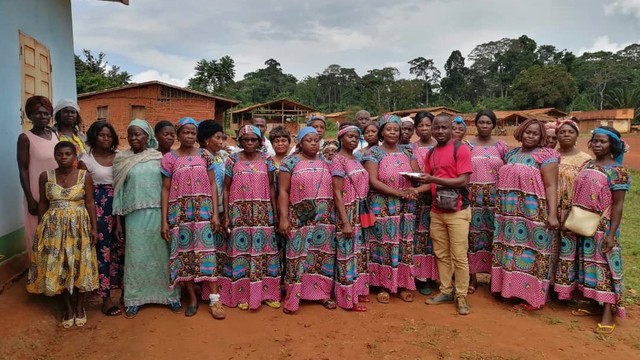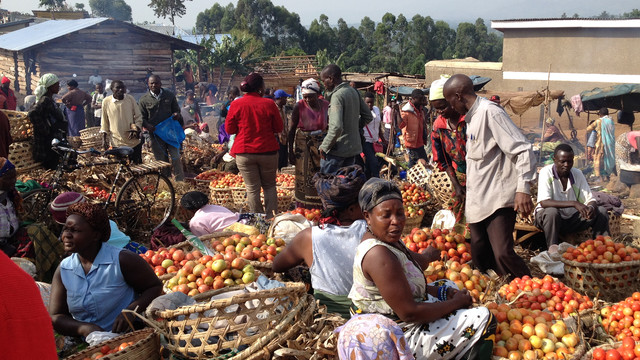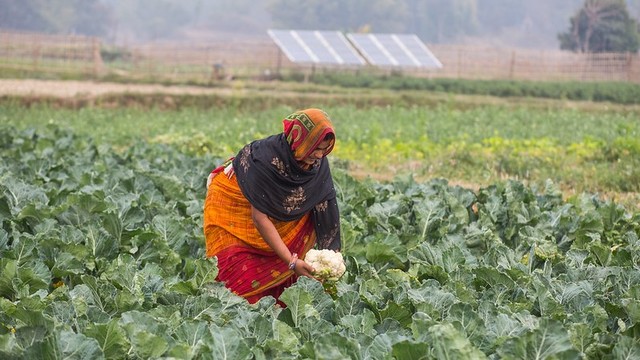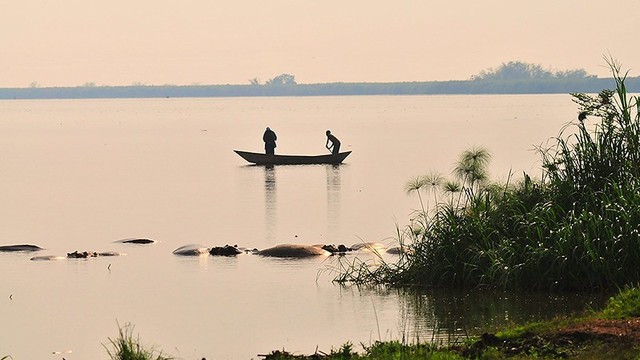Q&A: New policy champions communities in the push to conserve Uganda’s wildlife
A new community conservation policy is aiming to tackle poaching and reduce the number of human-wildlife conflicts in Uganda. George Owoyesigire, of the Uganda Wildlife Authority, explains.
George Owoyesigire (GO) is director of the community conservation sub-directorate of the Uganda Wildlife Authority (UWA). For more than 20 years he has worked on the implementation of field conservation programmes and policies that make communities central to Uganda’s wildlife conservation efforts.
Here, Geoffrey Mwedde from IIED’s partner Wildlife Conservation Society Uganda puts questions to Owoyesigire about the aims, scope, and ambition of UWA’s exciting new community conversation policy and, with Ugandan communities facing a challenging situation due to COVID-19, the implications of the pandemic.

Q: Could you describe the history of community conservation approaches in Uganda?
A: During the colonial period, the government pursued a ‘fortress conservation’ strategy – enforcing wildlife protection laws with minimal involvement of local people. In the early 1920s, protected areas such as forest reserves were created.
The idea was to maintain large tracts of wildlife conservation areas but the process did not actively involve or consult local communities. The introduction of formal sport hunting allowed white colonial populations to hunt; meanwhile traditional hunting was banned, causing great displeasure and hardship for communities that were no longer able to freely access game meat. Communities felt disenfranchised of their traditional right to access resources.
Many of the conservation policies introduced during colonial rule remained in place, even after Uganda gained independence in 1962. It wasn’t until the late 1980s that we saw a shift in thinking. The then government realised that it needed to involve the people of Uganda in the conservation and management of wildlife – not only to protect species but to give local people a fair share of benefits from conservation initiatives.
The previous policies emphasised preservation rather than sustainable use and community participation. A number of issues were emerging. The human population was increasing and placing immense pressure on natural resources. Human-wildlife interactions and conflicts were increasing.
The 1996 Wildlife Statute (later enacted as the Uganda Wildlife Act 2000) recognised the role of local communities in wildlife conservation. Similarly, the 1999 National Wildlife Policy recognised community participation in wildlife management and influenced subsequent planning that created opportunities for communities to engage directly in and benefit from wildlife conservation.
Later, the 2014 revised National Wildlife Policy and recently revised and updated Uganda Wildlife Act (2019) re-emphasised and strengthened recognition of the role that communities can play in conservation.
This has since culminated into the recent review of the outdated 2004 Uganda Wildlife Authority Community Conservation Policy that seeks to facilitate effective implementation of community engagement programmes around wildlife conservation areas. The policy recognises the role communities can play in mitigating human-wildlife conflicts, detection of wildlife crime and intelligence gathering – for example initiating mechanisms for facilitating and engaging community informants and wildlife scouts to address conflicts and curtail poaching.
It also emphasises the need to restructure, streamline and strengthen UWA’s flagship community benefit-sharing and awareness programmes in order to achieve long-term impact on wildlife conservation and community livelihoods. Examples included planned development and effective implementation of community-led conservation action plans and livelihood enterprises to enhance rural incomes and mitigate poaching.
Q: The Uganda Wildlife Authority has recently updated its community conservation policy. Why has the old policy been revised?
GO: The previous 2004 community conservation policy was out of date. It did not recognise the role communities can play in addressing rising cases of human-wildlife conflicts, fighting organised wildlife crime and poaching in Uganda.

Ranger tracking chimpanzees at Kibale National Park, in Uganda (Photo: Kent MacElwee via Flickr, CC BY-NC-ND 2.0)
The old policy wasn’t aligned to other recent government policies and strategies. Further, it did not recognise the role communities can play in addressing a number of other emerging key issues and threats to conservation such as climate change.
Q: What are some of the policy’s key elements?
GO: It’s an ambitious policy, covering many areas. One area that it tackles head-on is mitigation of human-wildlife conflicts through engagement of community wildlife scouts. The policy also emphasises the need to tackle poaching. Key to developing this part of the policy was understanding the root causes of the problem. For example, some communities said they have no alternatives – they poach because their crops have been destroyed by wildlife. We heard how some are subsistence poachers while others do it for commercial reasons.
We want to create incentives for communities to report on, and to contribute to preventing, wildlife crime. One way we can do this is by providing alternative livelihood opportunities for communities. UWA has already formulated the ‘Community Livelihoods Support Programme Guidelines’ (2020) to guide effective implementation of the scheme.
If people have their own livestock, they don’t go into protected areas looking for meat; if they produce and sell their own coffee, they have enough income to buy meat and don’t need to go poaching. Targeted resources will be dedicated to alternative livelihood programmes, to curtail levels of poaching.
The policy also seeks to strengthen implementation of education and awareness programmes using both traditional and modern approaches. For example, people are still caught hunting in protected areas but claim they don’t know such hunting is illegal. Others do not understand the potential benefits they could accrue from helping to protect wildlife. Others do not understand the fines and penalties involved. So there’s a big focus on educating local people.
But, most importantly, the policy recognises that its success will lie in working closely with key local stakeholders – most notably civil society organisations and district local governments.
Q: What’s particularly innovative about the new policy?
GO: The policy’s mechanisms on capacity building to respond to poaching are very progressive. It seeks to build the capacity of community members – who’ll be known as community informants or scouts – to help with intelligence gathering. This hasn’t been done before. We will create incentives for communities to work with us to provide wildlife crime intelligence, and provide them with all the necessary training.
We also want to build the capacity of our own staff working to implement community conservation programmes around the wildlife parks and reserves. Community conservation staff collect a lot of information as part of their routine work, but in some cases may not share this information with law enforcement, intelligence agencies or even our own investigation departments.
The policy seeks to harmonise our internal processes so there is stronger, coordinated, and systematic interdepartmental co-operation. Traditionally, law enforcement has taken the lead and played a critical role, but now we want community conservation to complement their efforts to curtail poaching and address conflicts while promoting community development.
Q: Do you think this policy could inspire other countries in the region, in East Africa, or even internationally?
GO: Uganda is signatory to the East African Community Treaty (1999) under which countries are obliged to work together to promote development and protect natural resources – especially transboundary resources. The community-centric policies we’re implementing in Uganda could offer important lessons for other East African countries especially in the management of transboundary protected areas. There’s real opportunity to leverage this treaty and influence countries from the region to make communities part of their conservation efforts.
Uganda together with the Democratic Republic of the Congo (DRC) and Rwanda signed the Greater Virunga Transboundary Collaboration Treaty in 2015. One of the key guiding principles under Article 5(c) of the treaty is to promote intervention that will ensure poverty reduction and sustainable livelihood improvement around the wildlife protected areas in the Greater Virunga Landscape.
DRC and Rwanda stand a chance of benefiting from Uganda’s diverse experience in community engagement and benefit-sharing programmes.

A community-based wildlife crime prevention action plan has been created for Queen Elizabeth National Park (Photo: Jocelyn Saurini, via Flickr (CC BY 2.0))
Q. The policy talks about creating a wildlife crime prevention action plan. How does this relate to the community-based wildlife crime prevention action plans created for Murchison Falls and Queen Elizabeth National Park? Does it replace them or build on them?
GO: For two years now we’ve been implementing community-based wildlife crime prevention action plans around Murchison Falls and Queen Elizabeth following a project with support from IIED. We’ve learnt through this initiative that communities are very willing to work with us to tackle wildlife crime.
So, we’re building on this experience and recognising the utility of these action plans in our new community conservation policy. We hope to scale up and develop these plans for other protected areas in Uganda where wildlife crime is a problem.
Q: Now on to COVID-19. How has the pandemic affected community conservation work?
GO: It’s certainly a difficult time. The community conservation work involves regular meetings and consultations with community members. But the lockdown and social distancing measures prevent us from such gatherings, so our work is brought to a standstill.
Many communities benefit from tourism while supporting conservation. Last year alone we gave out over UGX 10 billion (around US$2 million) to local communities under the revenue sharing programme for development projects around several parks including Bwindi, Murchison Falls, Kibale and Lake Mburo. The revenue was from wildlife-based tourism.
But with COVID-19, our community conservation wardens haven’t been able to give the much-needed on-the-ground support and supervision we normally provide. With social distancing measures, we cannot tell whether these programmes are being implemented as planned to improve people’s wellbeing and ensure biodiversity conservation.
Tourism, more broadly, is of course taking a huge hit. This will affect the amount of funding available for tourism revenue sharing next year. On average, UWA is losing around UGX 7bn ($1.8 million) per month due to the outbreak and subsequent lockdown.
For example, the usually busy and thriving Buhoma community around Bwindi Impenetrable National Park currently has no tourists at all. Similarly, the Kibale Association for Rural and Environmental Development (KAFRED) around Bigodi village Kibale National Park used to generate over UGX 300 million annually from tourism – this has dropped to zero practically overnight.
We’re also concerned about a spike in poaching – communities claim that because of the lockdown they do not have enough food; they’re not working and they’re going hungry. Around Murchison Falls and Queen Elizabeth National Park we’re hearing reports of people laying snares to capture animals for food.
All this is derailing the good work we’ve done on anti-poaching. For example, between only February and May this year, we have recorded 367 suspects (531 suspects) compared to 163 cases (255 suspects) during the same period last year. This is not a good for us as a country and we have to work hard to reverse the situation. We need support and cooperation not only from local communities but also local and international partners.
Q: So, what’s next for the policy?
GO: Uganda Wildlife Authority hopes to launch the community conservation policy later this year in Kampala when it becomes safe to host a small gathering of colleagues. If you want more information on the new policy, email george.owoyesigire@wildlife.go.ug or gowoyesigire@yahoo.com.
IIED has been providing support to UWA as part of the ‘Implementing park action plans for community engagement to tackle illegal wildlife trade’ project funded by UK Aid. As part of this project, community conservation wardens receive peer-led training that strengthens their skills in engaging people living around Uganda’s protected areas in conservation activities.




